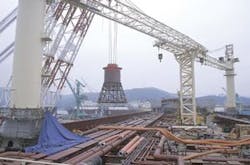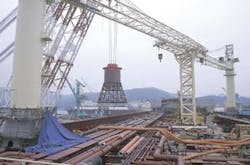White Rose crosses major milestones
Newfoundland's third offshore development on track for 2005/2006
Judy Maksoud
International Editor
White Rose, the third development in the Jeanne d'Arc basin 350 km east of St. John's, Newfoundland and Labrador, Canada, is on track for production in late 2005/early 2006.
According to Will Roach, general manager East Coast development for Husky Energy, Husky has adhered closely to its development schedule and has recently reached some noteworthy milestones.
With more than a year and a half left to bring the project onstream, Roach said, the overall level of completion for the FPSO is at 74%, with the actual level of completion of the topsides at 45%. The turret and hull are 99% complete.
A new "old" approach
Part of the reason for the success to date is the result of the approach Husky has taken toward the project. "We've set our contracts up so that we have the best opportunity to get the best people to help us control the exercise," Roach said.
SBM Imodco designed the disconnectable turret, which was fabricated by Gulf Piping Corp. in Abu Dhabi and was transported to Korea for integration into the vessel. The vast majority of the commissioning and testing, including a disconnect test, were done before it shipped to Marystown, Newfoundland. The turret will be mated with the topsides processing equipment at the Kiewit Offshore Services yard, a subcontractor to topsides contractor Aker Maritime Kiewit Construction. AMKC, a joint venture of Peter Kiewit Sons Co. Ltd. and Aker Oil and Gas Technology Canada, is responsible for topsides design, fabrication, construction, and commissioning.
null
The buoy was also fabricated by GPC under SBM supervision and was to arrive in Bay Bulls, Newfoundland, in early April to be installed this summer.
Samsung Heavy Industries, South Korea, built the FPSO hull, which was to arrive in Marystown in early April.
Mærsk Contractors is managing the overall FPSO construction and according to Roach, "It has worked perfectly."
The next milestone will be subsea installation, which begins in May. Husky awarded the subsea contract for White Rose to Technip Offshore Canada Ltd. The contract covers design, supply, and installation of the subsea system. The subsea production system includes 42 km of flexible risers, flowlines, and umbilicals, five subsea manifolds, up to 21 christmas trees and wellheads distributed across three glory hole sites.
The well services bids went out separately, and a number of them were awarded to Schlumberger. "We have tried to bundle a lot of the services. We bid them all independently, then looked at the overall offers," Roach said. Schlumberger won eight of the bids, a fact that Roach sees as an advantage for the project.
"The idea of getting Schlumberger in was to get a very strong partner that can help with technology and expertise," Roach said.
So Husky is looking to the expertise Schlum- berger brings to the team. "That means us listening to them a little more than in the traditional contractual relationship," Roach said.
"There's a bit of having to work in a slightly different way, and I am a firm believer in Husky getting a lot of advantage out of that," he said.
Surmounting challenges
Though the project is progressing well, it has not been without challenges. Glory hole excavation, for example, did not go as smoothly as anticipated.
Glory holes are 9-m deep excavations in the seabed that protect the subsea wellheads and associated production equipment against icebergs. The holes were dredged in water depths of 115-130 m, which posed significant challenges to Boskalis' clam-dredging technology. In the end, Boskalis excavated two of the glory holes, while the third was excavated by Jan de Nul, using a trailing-head, suction-dredging system.
Another challenge, according to Roach, is associated with the decision to do much of the construction work locally, a first for a project of this size.
Through an extensive topsides bidding process, and based on a design which enabled the involvement of regional fabrication sites, the Marystown facility was given an opportunity to be involved in the White Rose project. According to Roach, the company believes that the work can be effectively carried out there. Roach hopes successful completion of the project will create a legacy.
"The lasting benefit White Rose will have for the province is proving the work can be done locally," Roach said.

